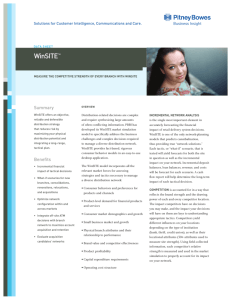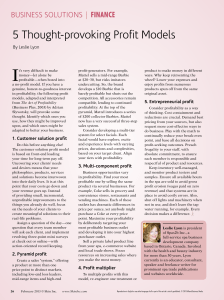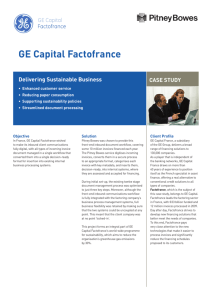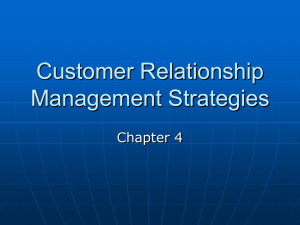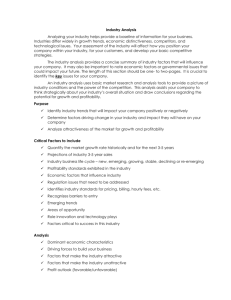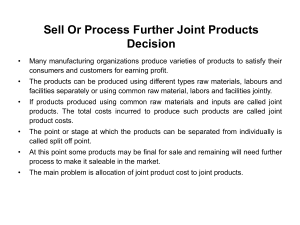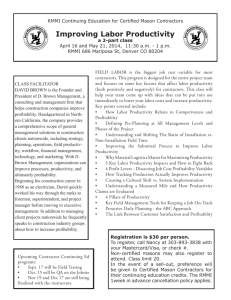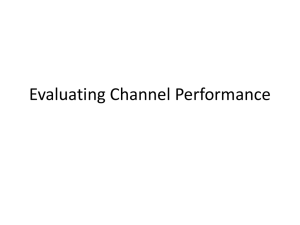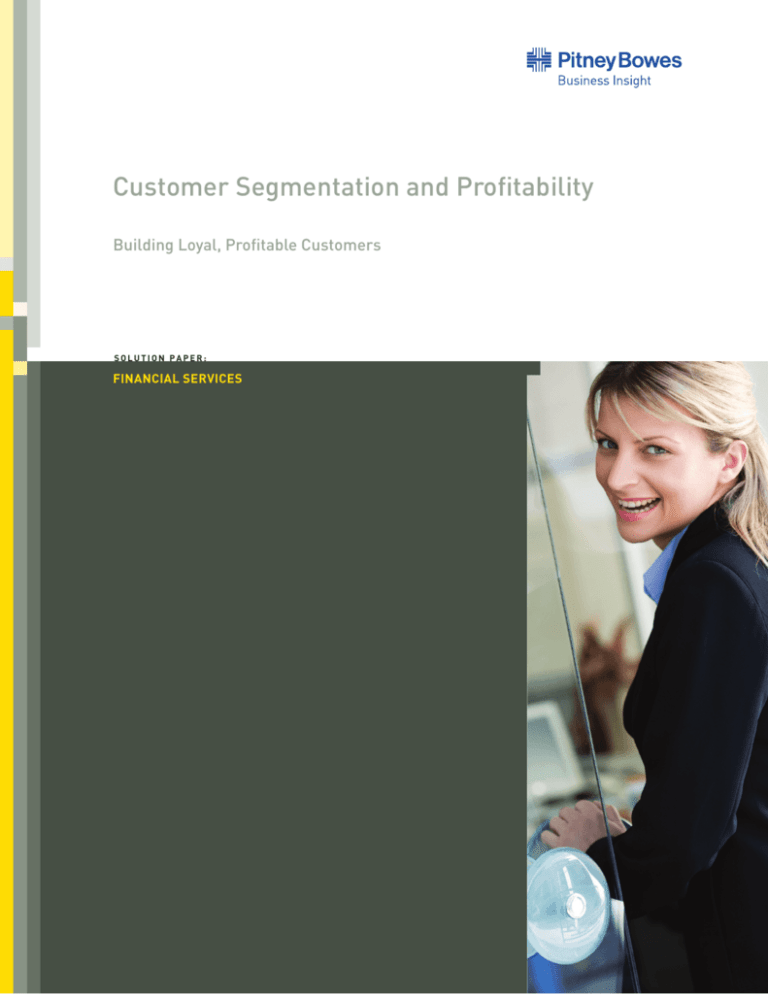
Customer Segmentation and Profitability
Building Loyal, Profitable Customers
SOLUTION PAPER:
FINANCIAL SERVICES
SOLUTION PAPER: FINANCIAL SERVICES
Customer Segmentation and Profitability
Building Loyal, Profitable Customers
2
ABSTRACT
FINANCIAL INSTITUTIONS HAVE BEGUN THE PROCESS OF RECOVERY, AND ARE CAUTIOUSLY LOOKING FORWARD TO FUTURE GROWTH.
WITH SLOW BUT CONTINUED GROWTH IN THE HOUSING AND JOB MARKETS, FORECLOSURES AND BANKRUPTCIES REMAIN HIGH
PUTTING A CONTINUED STRAIN ON THE INDUSTRY. ADD TO THAT, NEW REGULATORY OVERSIGHT REQUIRES FINANCIAL INSTITUTIONS
TO STRENGTHEN BOTH CONTROLS AND COMPLIANCE REPORTING. AS THE RECOVERY CONTINUES, FINANCIAL INSTITUTIONS LOOK
TO IMPROVE BOTH THEIR EFFICIENCY RATIO AND CROSS-SELL AND UP-SELL OPPORTUNITIES, WHILE INSTITUTING SUCCESSFUL
PROCESSES TO BRING AND KEEP CUSTOMERS ONBOARD. IN EACH OF THESE CASES, THE KEYS TO SUCCESS ARE TO GROW REVENUES
AND DEPOSITS WITHOUT ADDING EXPENSE, ALL WHILE OBTAINING AND EXTENDING CUSTOMER SATISFACTION AND LOYALTY.
FINANCIAL INSTITUTIONS MUST DEAL WITH YET ANOTHER ASPECT OF THE ECONOMIC FALLOUT – CUSTOMER SATISFACTION. THE GLOBAL
BANKING LANDSCAPE HAS BEEN FOREVER CHANGED BY THE CREDIT CRISIS, LEAVING ISSUES OF TRUST, CUSTOMER ATTRITION, BRAND
LOYALTY, AND THE RESULTING REVENUE DECLINES TRAILING IN ITS WAKE. TO ENSURE SUCCESS, FINANCIAL INSTITUTIONS, WHILE
MARSHALLING RESOURCES TO RAISE CAPITAL AND CUT COSTS WHERE POSSIBLE, MUST NOT OVERLOOK THEIR LIFEBLOOD - ONGOING
ACQUISITION, OPTIMIZATION, AND RETENTION OF CUSTOMERS. THE BOTTOM LINE IS THAT FINANCIAL INSTITUTIONS MUST IMPROVE THE
CUSTOMER EXPERIENCE TO KEEP CUSTOMERS HAPPY, SATISFIED, AND LOYAL.
TO SECURE AND BOOST CUSTOMER RETENTION, WHILE MAINTAINING SUCCESSFUL RELATIONSHIPS, FINANCIAL INSTITUTIONS MUST
FIND NEW AND INNOVATIVE WAYS TO COMMUNICATE WITH CUSTOMERS. ADVANCES IN TECHNOLOGY HAVE FORCED INSTITUTIONS TO
IMPLEMENT A WIDE RANGE OF COMMUNICATION VEHICLES – FROM WEB, MOBILE PHONE, AND EMAIL, TO TEXT MESSAGES AND SOCIAL
NETWORKING SITES – DEPENDING ON THE CUSTOMER’S PREFERENCE. FINANCIAL INSTITUTIONS MUST EMBRACE, IMPLEMENT, AND
TAKE ADVANTAGE OF THESE VARIOUS TYPES OF CHANNELS TO SUCCEED IN TODAY’S NEW CUSTOMER-DRIVEN ENVIRONMENT.
www.pbinsight.com
FINANCIAL INSTITUTIONS MUST IMPROVE THE CUSTOMER EXPERIENCE
TO KEEP CUSTOMERS HAPPY, SATISFIED, AND LOYAL
Overview
Understanding the Lifecycle of a Customer
While most consumers need a banking relationship, the
The customer lifecycle can be divided into three functional
top 25% of customers account for nearly all of a financial
areas – acquire, optimize, and retain.
institution’s profits. Financial institutions require reliable
ways to identify revenue potential, assess needs, personalize
The acquisition phase consists of market research,
cross-sell and up-sell activities, build loyalty, and offer
marketing, and customer onboarding. It is critical for
convenient, effective service to the targeted, high-yield
financial institutions to maximize the relationship with the
accounts. Fortunately, financial institutions can employ
customer. Acquisition is the opportune time to determine
these same tactics to the remaining 75% of accounts to
not only the best customers, but what they need and how
help build effective relationships that match both the
to cross-sell. In fact, activities performed in the first 90
bank’s and the customer’s needs. In other words, the less
days, which is the time period that defines onboarding, are
profitable accounts require highly automated interactions,
paramount to the success of the customer relationship.
while the high-yield accounts benefit from differentiated
and better levels of service.
Next is the optimization phase, which consists of customer
profitability, event-based marketing, cross-selling and
As financial institutions have come to realize, unprofitable
up-selling, and channel network optimization. After the 90
customers can be classified into the following three groups:
day onboarding period, it is important to determine how to
• Unprofitable due to lack of profitable relationships
• Unprofitable due to improper charging or inappropriate
maximize and optimize networks and processes, and create/
deliver relevant, cost-effective communications to best serve
those customers and keep them loyal.
servicing channels
• Truly unprofitable
The final phase, the retention phase, entails implementing
To avoid the unprofitable pitfalls, financial institutions
accurate customer profiles. It is advantageous for financial
must implement processes and tools that enable them to
capture higher wallet share, migrate customers to more cost
effective channels, and properly identify customers to be
effective retention and rationalization programs based on
institutions to fully understand the identities of their two
types of customers - their best and their less-than-best.
These two customer groups are easily differentiated – the
de-marketed or divested.
best are the high-yield clients that the financial institutions
To maintain a profitable relationship while driving the
high-maintenance clients that the financial institution
potential for sales, financial institutions must not only gain
a true understanding of their customers, but they must
also peer into the proverbial crystal ball to anticipate their
needs.
strive to retain, while the less-than-best are those low-yield,
would benefit from divesting. As mentioned earlier, the
top 25% of high-yield accounts and the remaining 75% of
less profitable accounts can benefit from the same set of
processes and relationship building. In fact, instead of only
focusing on the high-yield accounts, financial institutions
must innovate and look for ways to turn low-yield accounts
into profitable accounts.
3
SOLUTION PAPER: FINANCIAL SERVICES
Customer Segmentation and Profitability
Building Loyal, Profitable Customers
4
Customer Profitability and Segmentation
Challenges
To ensure successful and profitable relationships, financial
institutions must understand their customers, anticipate
their needs and requirements, and drive sales. To
to ensure clean and validated customer data, place
themselves in the best possible defensive position by
knowing and validating their customer’s identity.
Identifying and Understanding the Customer
accomplish these objectives, institutions must be able to
Financial institutions begin the customer profitability and
answer the following, all-important questions:
segmentation process by gaining a full 360° view of their
• Who are my best customers?
• What products and services do they require?
• How do their product needs vary across regions and
branch trade areas?
customers with clean, accurate data. This is critical as
they must learn how to uncover and then maximize their
most valuable asset: tremendous amounts of customer
information. Securing this foundation is necessary not only
to successfully identifying the customer through accurate
data, but by understanding their needs and preferences.
• How can I package products, based on these needs, to
Clean data is the essential first building block upon which a
maximize value and corresponding fee revenue?
successful strategy is built.
• How can I cultivate a better relationship through
communication?
• Which communication channels do they prefer?
To get clean, high-quality customer data, financial
institutions must start by matching and consolidating
existing data into a single, comprehensive customer record.
This can provide the insight needed to enhance customer
These questions represent the fundamental challenges
loyalty and lifetime value. Processes used within a customer
faced by every financial institution looking to successfully
segmentation and profitability solution can take a myriad
implement a customer profitability and segmentation
of information from multiple customer touch-points;
process. To get answers, institutions must address the
update, link, and consolidate the data; secure identification
following four areas:
and compliance; then transform the information into
• Identifying and understanding the customer – both at
enterprise-wide business intelligence.
the macro/trade area level and the individual consumer
level
• Maximizing customer potential and profitability
• Personalizing customer communications
• Delivering targeted communications
Additionally, financial institutions must be prepared to
Down the line, this rich customer information can help
financial institutions reap further benefits such as:
• Increasing customer loyalty through targeted
communications
• Generating revenue with more effective cross-marketing,
cross-selling, and up-selling
answer two more questions, “Do I know the identity of
• Boosting campaign effectiveness through consolidated
my customer?” and “Can I validate that identity?” These
customer profiling and householding
answers are essential to minimize fraud losses and to
• Reducing marketing costs by eliminating redundant
comply with today’s stringent governmental requirements.
mailings
Financial institutions that implement automated solutions
www.pbinsight.com
ANALYTICS, SPECIFICALLY PREDICTIVE ANALYTICS, UTILIZES
LOCATION INTELLIGENCE TO PREDICT CUSTOMER BEHAVIOR
Maximizing Customer Potential and
Profitability
Analytics, specifically predictive analytics, utilizes location
intelligence to predict customer behavior. By employing
proven predictive analytic methodologies, financial
Once a financial institution has identified their customers
institutions can:
and ensured the accuracy of their customer data, the
next step is to maximize each customer’s potential and
• Gain unparalleled insight into markets
profitability. This is a critical step, as it not only identifies
• Attract more profitable customers
and rewards the best and most profitable customers, it, at
the same time, highlights the customers who would benefit
• Maximize investments in sales and delivery channels
from relationship expansion, product and service migration,
• Secure a competitive advantage in the marketplace
or divestiture.
• Distribute branches more effectively
To garner this insight and information, financial
• Align branches with defendable strategic performance
institutions must implement a solution that employs
goals rooted in real-world customer behaviors and
both analytics and segmentation. This combination helps
comprehensive market data
institutions determine customer needs and behaviors, and
• Explore and quantify potential opportunities before
aides in increasing customer value over time.
making the critical decisions that impact the bottom line
REVENUE
Maximizing Customer Profitability
Better cross /
up-selling
Recovery of
potentially valuable
customer relationships
More efficient
customer retention
Acquisition
Optimization
Retention
Faster termination
of potentially less
valuable customer
relationships
More efficient
acquisition of
new customers
Customer Lifecycle
Peppers & Rogers Group
TIME
5
SOLUTION PAPER: FINANCIAL SERVICES
Customer Segmentation and Profitability
Building Loyal, Profitable Customers
6
With clean, accurate data, financial institutions can now
But, delivering personalized communications requires more
begin to get a 360° view of their customers. A detailed,
than just manually tailoring a standard document template.
chronological roadmap that focuses on predictive analytic
Financial institutions benefit greatly by implementing an
models will help financial institutions:
automated customer communication management (CCM)
• Optimize distribution networks
solution to leverage the insights made available from
segmentation.
• Define untapped opportunities and maximize branch
performance through a better sales goal-setting process
An effective, enterprise-wide CCM solution includes four
• Analyze and visualize market opportunities for sales
types of communications – high volume, on-demand,
planning activities
interactive, and multi-channel delivery.
• Identify the next best purchase and profitability for
• High volume communications are normally processed in
individual customers or new prospects
batch, pushing high transaction rates
Additionally, to identify how best to serve the most
profitable customers, financial institutions must implement
• On-demand communications are created with available
external data, and delivered in real-time via web services
a distribution strategy. This strategy helps determine and
• Interactive communications are individualized, ad-hoc
utilize the communication vehicles preferred by customers,
documents that require real-time information and a
while optimizing sales and forecast capabilities.
human touch to complete
To benefit the financial institution and the customer,
The fourth step in the CCM solution is not a type of
simultaneously, these analytics and segmentation solutions
communication, but a method of delivery. The ability
must run in the background, integrating powerful analytics
to offer customers multi-channel delivery is critical in
and analyzing data at the first point of contact - data entry.
the quest to achieve the utmost satisfaction. Delivery
method preferences vary significantly from customer to
Personalizing Customer Communications
Having successfully implemented the processes needed
to obtain clean, accurate customer data, and maximize
the customer’s potential, the next step is for financial
institutions to implement capabilities that enable
effective marketing. This includes educating the customer
on the next best sell, and the benefits of mutually
beneficial transaction channels through personalized and
targeted communications. These effective, cost-efficient
communications provide customers with the right message,
via the right channel, delivered at the right time.
These targeted customer communications are vital elements
to providing quality service, boosting the customer
experience, and improving loyalty and retention rates.
www.pbinsight.com
customer, so ensuring that processes are in place to deliver
communications via traditional print/mail, email, SMS,
and fax, is important for financial institutions. Creating
communications plans by customer segment allows high
customization to meet the preferences of high-yield
customers, while financial institutions can use a less
expensive approach to communicate with their low-yield
customers.
By employing the right solutions, financial institutions can
enable one-to-one marketing by composing, delivering,
and coordinating their choice of print, electronic, email,
or mobile marketing campaigns through a central source.
Institutions can maintain brand consistency across
channels, reduce duplicate efforts, and most importantly
THE ABILITY TO OFFER MULI-CHANNEL DELIVERY IS CRITICAL IN THE
QUEST TO ACHIEVE THE UTMOST CUSTOMER SATISFACTION
increase the ability to provide customers with the
Pitney Bowes Business Insight is the leading provider of
personalized financial guidance they desire.
location intelligence and predictive analytic solutions for
financial institutions worldwide, with more than 20 years
Delivering Targeted Communications
As the final aspect of the customer segmentation and
profitability solution, it is important to understand how
enabling technologies, empowered by a 360° customer view,
will improve the delivery of targeted communications.
Direct mail contact with customers via monthly statements
and account updates can, of course, create huge postage
and mailing expenditures. But by having targeted
communications that utilize clean customer data, financial
institutions can enhance marketing response rates, drive
mailing efficiencies, and reduce related costs. In addition,
insert, pre-sort, and delivery solutions can increase
efficiencies, improve customer communications, and
maximize postal savings.
Ultimately, financial institutions can use their data to better
target marketing campaigns, sending finely honed messages
to customers via their preferred channels - be it print,
online, email, or SMS. Not only will the marketing message
be delivered, institutions can alert the right departments
and sales staff when customer communications are
received, enabling appropriate and timely follow-up.
Together, these capabilities ensure cost-efficient delivery
of the very messages that will optimize both customer
satisfaction and loyalty.
Pitney Bowes Business Insight Leads the Way
Pitney Bowes Business Insight offers an end-to-end
solution that helps maximize customer segmentation and
profitability insight and efforts. Pitney Bowes Business
Insight offers solutions - from both a technology and
consulting perspective - to help every step of the way.
of experience delivering solutions specifically tailored to
the financial industry. More than 150 different financial
institutions currently rely on our expertise, enabling
the implementation of successful and effective customer
segmentation and profitability solutions.
Pitney Bowes Business Insight’s innovative solutions provide
financial institutions with the insights needed to make
more informed decisions on critical aspects of the business
– exactly what is needed in the never-ending quest for
sustained profitable growth and customer satisfaction.
7
UNITED STATES
One Global View
Troy, NY 12180
1.800.327.8627
pbbi.sales@pb.com
www.pbinsight.com
CANADA
26 Wellington Street East
Suite 500
Toronto, ON M5E 1S2
1.800.268.3282
pbbi.canada.sales@pb.com
www.pbinsight.ca
EUROPE/UNITED KINGDOM
Minton Place
Victoria Street
Windsor, Berkshire SL4 1EG
+44.1753.848200
pbbi.europe@pb.com
www.pbinsight.co.uk
ASIA PACIFIC / AUSTRALIA
Level 7, 1 Elizabeth Plaza
North Sydney NSW 2060
+61.2.9437.6255
pbbi.australia@pb.com
pbbi.singapore@pb.com
pbbi.china@pb.com
www.pbinsight.com.au
© 2010 Pitney Bowes Software, Inc. All rights reserved.
Pitney Bowes Business Insight is a division of Pitney Bowes Software Inc. The Pitney Bowes logo is a registered trademark of Pitney Bowes Inc.
Aura is a protected trademarks of Pitney Bowes Software Inc. All other brand names and trademarks are the property of their respective owners.
92432 AM 1004


